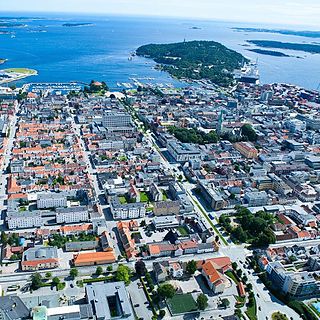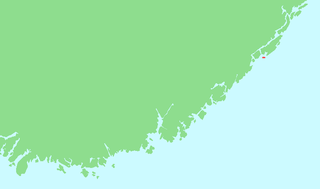
Aust-Agder was a county (fylke) in Norway until 1 January 2020, when it was merged with Vest-Agder to form Agder county. In 2002, there were 102,945 inhabitants, which was 2.2% of Norway's population. Its area was 9,212 square kilometres (3,557 sq mi). The county's administrative center was the town of Arendal.

Kristiansand is a city and municipality in Agder county, Norway. The city is the fifth-largest and the municipality is the sixth-largest in Norway, with a population of around 116,000 as of January 2020, following the incorporation of the municipalities of Søgne and Songdalen into the greater Kristiansand municipality. In addition to the city itself, Statistics Norway count four other densely populated areas in the municipality: Skålevik in Flekkerøy with a population of 3,526 in the Vågsbygd borough, Strai with a population of 1,636 in the Grim borough, Justvik with a population of 1,803 in the Lund borough, and Tveit with a population of 1,396 in the Oddernes borough. Kristiansand is divided into five boroughs; -Grim, which is located northwest in Kristiansand with a population of 15,000; Kvadraturen, which is the centre and downtown Kristiansand with a population of 5,200; Lund, the second largest borough; Søgne, with a population of around 12,000 and incorporated into the municipality of Kristiansand as of January 2020; Oddernes, a borough located in the west; and Vågsbygd, the largest borough with a population of 36,000, located in the southwest.

Arendal is a municipality in Agder county in southeastern Norway. Arendal belongs to the region of Sørlandet. The administrative centre of the municipality is the city of Arendal. Some of the notable villages in Arendal include Rykene, Eydehavn, Færvik, Strengereid, Kongshavn, Kilsund, Brattekleiv, Torsbudalen, Longum, Saltrød, Staubø, Vrengen, and Kolbjørnsvik. The offices of UNEP/GRID-Arendal are also located in the city of Arendal.

Grimstad is a municipality in Agder county, Norway. It belongs to the geographical region of Sørlandet. The administrative center of the municipality is the town of Grimstad. Some of the villages in Grimstad include Eide, Espenes, Fevik, Fjære, Håbbestad, Hesnes, Homborsund, Jortveit, Kroken, Landvik, Nygrenda, Prestegårdskogen, Reddal, Roresand, Rønnes, Skiftenes, Tjore, Vik, and Østerhus.

is municipality in Agder county, Norway. It is located in the traditional district of Sørlandet. The administrative center is the town of Tvedestrand. There are many villages in the municipality including Dypvåg, Fiane, Gjeving, Gødderstad, Grønland, Kilen, Klåholmen, Krokvåg, Laget, Lyngør, Nesgrenda, Østerå, Sagesund, Sandvika, and Songe.

Froland is a municipality in Agder county, Norway. It is part of the traditional region of Sørlandet. The administrative center is the village of Blakstad, which along with Osedalen form the main population center of the municipality. Other villages in Froland include Bøylefoss, Bøylestad, Froland, Frolands verk, Heldalsmo, Hinnebu, Hynnekleiv, Jomås, Lauvrak, Libru, Løvjomås, Mjåvatn, Mjølhus, Mykland, and Risdal.

Lillesand is municipality in Agder county, Norway. It is part of the traditional district of Sørlandet. The administrative center of the municipality is the town of Lillesand. Some of the larger villages in Lillesand municipality include Åkerøyhamn, Brekkestø, Gamle Hellesund, Helldal, Høvåg, Ribe, Skottevik, Trøe, Ulvøysund, and Vesterhus.

Southern Norway is the geographical region (landsdel) along the Skagerrak coast of southern Norway. The region is an informal description since it does not have any governmental function. It roughly corresponds to the old petty kingdom of Agder being coextensive with the county, as well as the two former counties of Vest-Agder and Aust-Agder. From New Year 2020, the two counties have been merged into one county, Agder. The total combined area of Vest-Agder and Aust-Agder counties is 16,493 square kilometres (6,368 sq mi). The name is relatively new, having first been used in Norway around 1900.

Fjære is a former municipality in the old Aust-Agder county in Norway. The 60.4-square-kilometre (23.3 sq mi) municipality existed from 1846 until 1971. It was located to the north of the town of Grimstad. The name is still used to refer to that area, which is now a part of Grimstad municipality in Agder county. The administrative centre of Fjære was the village of Vik, just east of the historic Fjære Church. Other villages in Fjære included Fevik, Dømmesmoen, Frivold, Kroken, and Rønnes.

Øyestad is a former municipality in the old Aust-Agder county in Norway. The 96-square-kilometre (37 sq mi) municipality existed from 1838 until 1992, when it was merged into the present-day municipality of Arendal, which is now located in Agder county. At the time of its dissolution, the municipality of Øyestad encompassed most of the coastline between the towns of Grimstad and Arendal, along with the forested areas along the Nidelva river heading inland. Back in 1838, however, the municipality was far larger in size. The administrative centre was the village of Bjorbekk near the Bjorbekk Church.

The Grimstad Line was a 22-kilometer (14 mi) long railway line between Grimstad and Rise in Norway. The line was a branch of the Arendal Line, which is in turn a branch of the Sørland Line. Opened as the Grimstad–Froland Line on 14 September 1907, it was originally a private railway. The line was nationalized and taken over by the Norwegian State Railways in 1912. The railway was originally built with 1,067 mm narrow gauge, but was converted to standard gauge in 1936. Because of the cumbersome transfers, the line had few passenger and little freight. It was closed and demolished in 1961.

Vennesla Station is a railway station located in the village of Vennesla in the municipality of Vennesla in Agder county, Norway. Located along the Sørlandet Line, the station is served by express trains to Oslo and Kristiansand. The trains are operated by Go-Ahead Norge.

Merdø is an island in Arendal municipality in Agder county, Norway. The 0.3-square-kilometre (74-acre) island lies along the Skagerrak coast, near the entrance to the Galtesundet, the main shipping channel leading to the town of Arendal on the mainland. The islands of Tromøy and Hisøya lie to the north and northwest. The small islands of Ærøya and Havsøya lie to the southwest. A part of the island is included in Raet National Park.
Ansic AS, trading as FlyNonstop, was a virtual airline which operated out of Kristiansand Airport, Kjevik, Norway, in 2013. The airline had a 100-passenger Embraer 190 operated by Denim Air. FlyNonstop was owned by Espen Hennig-Olsen, and focused on full service on flights to primary airports serving the tourist market. The company slogan was Norwegian: Fra der du bor. Til dit du skal.

Skomvær was the name of a steel-hulled barque built in 1890 for J. C. & G. Knudsen in Porsgrunn, Telemark, Norway. The ship, which was designed by naval architect Randulf Hansen and constructed at Laxevaags Maskin- og Jernskibsbyggeri in Bergen, was the first sailing ship constructed with steel in Norway and for a time the largest Norwegian sailing vessel ever built. However, the ship struggled to compete in the 20th century with the advent of the steamship, and in 1924 she was decommissioned and sold for scrap.
Randulf Hansen was a Norwegian ship designer. He was considered to be one of the country's leading naval architects of iron and steel ships. Among his designs were the British passenger liner SS Britannia (1887) and the Norwegian barque Skomvær (1890).

Grimstad is a town in Grimstad municipality in Agder county, Norway. The town is also the administrative centre of the municipality. It is located on the Skaggerak coast in Southern Norway along the Groosefjorden, between the towns of Arendal and Lillesand. The 10.02-square-kilometre (2,480-acre) town has a population (2019) of 13,543 and a population density of 1,352 inhabitants per square kilometre (3,500/sq mi). In Norway, Grimstad is considered a by which can be translated as either a "town" or "city" in English.

Fevik Church is a chapel of the Church of Norway in Grimstad Municipality in Agder county, Norway. It is located in the village of Fevik. It is an annex chapel in the Fjære parish which is part of the Vest-Nedenes prosti (deanery) in the Diocese of Agder og Telemark. The white, concrete and wood chapel was built in a long church style in 1976 using designs by the architect Lindefjell. The chapel seats about 100 people.

Arendal is a city in Agder county, Norway. The city is the administrative centre of the municipality of Arendal and the seat of the County Governor of Agder. The city also includes a small area in the neighbouring municipality of Grimstad as well. In Norway, Arendal is considered a by which can be translated as either a "town" or "city" in English.























